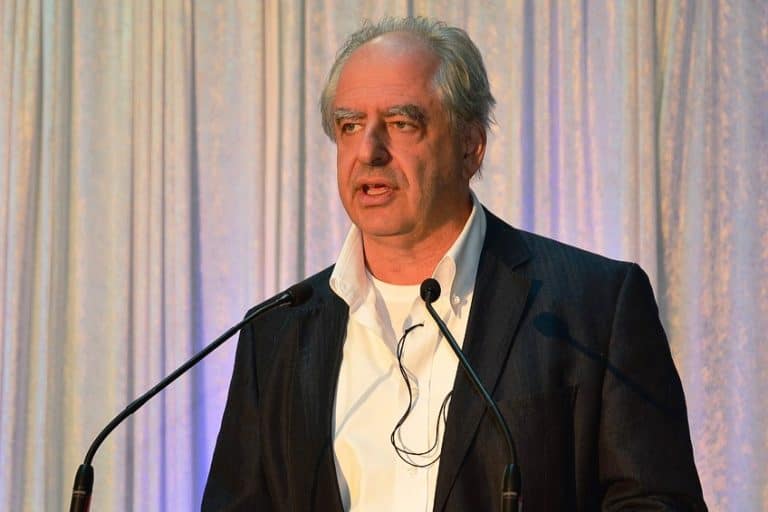George Byrne – Finding Inspiration in the Mundane and Ordinary
George Byrne is a contemporary Australian artist known for his vibrant and geometric compositions that explore the intersection of urban landscapes and abstract forms. Born in Sydney and now based in Los Angeles, Byrne’s work captures the essence of cities through bold colors, clean lines, and dynamic perspectives. With a background in photography, Byrne’s unique visual language transforms everyday scenes into mesmerizing artworks that invite viewers to reconsider their perceptions of space and environment.
Key Takeaways
- George Byrne transforms urban landscapes into abstract art through photography.
- His works reflect influences from notable artists and are part of international collections.
- Byrne’s art represents the intersection of contemporary technology and traditional aesthetics.
George Byrne: The Artist and His Origins
| Birth | 1976 |
| Death | Present |
| Place of Birth | Sydney, Australia |
| Genre of Work | Photographer |
George Byrne is an Australian-born artist known for his unique photographic approach to urban landscapes, which he turns into painterly abstractions. He was born in 1976 and was educated at the Sydney College of the Arts. Byrne’s work has its roots in movements like New Topographics, which blends elements of everyday scenes with fine art, and the influences of notable artists like Wim Wenders and David Hockney are evident in his style. By carefully selecting his subjects and applying a keen eye for color and composition, Byrne transforms the mundane into the extraordinary, challenging viewers’ perceptions of the urban environment.
In Byrne’s hands, the landscapes of Los Angeles, a city known for its sprawling urbanity, become canvases of color and geometry. His photographic process often involves playing with different colors and shapes to highlight the abstract over the literal, inviting a deeper contemplation of the spaces that people pass by daily. Through his lens, Byrne showcases how the interplay of light, shadow, and architectural forms can tell a unique story, separate from their functional existence. His work has amassed international acclaim, finding a place in collections and galleries around the world, and showcasing his role as a modern artist who seamlessly marries technology with a traditional aesthetic sensibility.
Early Life and Education
George Byrne was born in Sydney, Australia, in 1976. Embarking on his artistic journey, he pursued formal education at the Sydney College of the Arts, where he honed his skills and understanding of the craft. Byrne’s foundational years in Sydney provided him with technical expertise and the creative launchpad for his future work in photography.
Photographic Style and Influences
Byrne’s photographic style is often described as “painterly abstractions”, a method where the lines between photography and painting blur. This approach results in images where colors and shapes are as integral as the subjects themselves. Byrne draws his stylistic inspiration from a palette of renowned artists, including David Hockney, Ed Ruscha, and the geometric simplicity of Mondrian.
His works also resonate with the legacies of William Eggleston and Andreas Gursky, suggesting a lineage that tracks back to some of the most influential names in art and photography.
Current Career
Based in Los Angeles, Byrne continues to create and showcase his work. He has participated in various exhibitions and artist residencies, such as the one at SOHO HOUSE in December 2016. His photography has not just graced galleries but has also featured in unique collaborations, like the exclusive release of Pink Wall #3 at Paul Smith in 2022. Byrne’s current career is marked by his dedication to capturing and transforming urban landscapes into bodies of color and form, a testament to his unique artistic vision.
The Aesthetic of George Byrne’s Photography
George Byrne’s photography is distinguished by his unique application of composition and color to construct abstractions that transform everyday scenes into works resonant with beauty.
Composition Techniques and Visual Form
Byrne’s approach to composition is both intentional and nuanced. He employs a keen eye for shapes, patterns, and shadows which serve as the foundational elements in his visual abstractions. His work reflects an influence from modernist painting, particularly in how he assembles constituent parts of a scene. George Byrne treats his subject matter as a form, carefully arranging lines and geometric shapes to lead the viewer’s eye and create balance within the frame of the camera.
This meticulous orchestration of visual elements gives rise to images that reveal the unexpected beauty in mundane landscapes, suggesting a painterly aspect to his aesthetic.
The Role of Color and Light
Byrne wields color and light as tools to modulate the mood and establish the atmosphere within his photographs. He capitalizes on the vivid colors of the urban environment and the natural play of light and shadow, resulting in a rich chromatic palette and deep contrasts. These elements of colour are not merely decorative; they are substantive, contributing to the overall abstraction and transformation of the reality into painterly abstractions. His careful attention to detail in how light delineates forms, illuminates surfaces, and casts shadows is pivotal in constructing the abstract quality that characterizes his work.
George Byrne’s Contributions to Contemporary Art
George Byrne has garnered recognition in the field of contemporary art for his distinct photographic style and his ability to transform everyday landscapes into abstract compositions. His work is a confluence of photography and fine art, echoing the aesthetic sensibilities of the New Topographics Photography Movement.
Exhibitions and Shows
- Solo exhibitions: Byrne’s first major solo exhibition, which marked a high point in his career, served as a significant testament to his talent within the fine art domain, garnering attention across the art community.
- Group exhibitions: Byrne has participated in several group shows, contributing to a collective representation of contemporary art perspectives.
Publications and Collaborations
- Books: His work is often encapsulated in printed form, bringing his abstract renditions of landscapes to a broader audience through various art publications.
- Collaborations: Byrne’s collaborations, such as his residency at SOHO HOUSE in Los Angeles in December 2016, reflect his ongoing engagement with the artistic community. His connection with artists like Margot Ross highlights the interdisciplinary nature of his work within the nexus of photography, art, and design.
Technological Influence and Artistic Process
George Byrne’s work showcases a progressive blend of photography expertise and the application of the latest technological tools, which together crystallize into his signature aesthetic.
Evolution from Film to Digital
Byrne, now based in Los Angeles, began his journey in the world of art using medium-format film cameras. This traditional approach laid the foundation for his understanding of composition and the technical aspects of photography. With advancements in photography technology, he gradually transitioned to digital methods. The shift from using film cameras to embracing digital mediums allowed a more dynamic creative process.
Byrne’s transition is reflected in his artwork, where the technical precision afforded by film photography merges with the flexibility and immediacy of digital techniques.
The Intersection of Photography and Technology
Byrne’s creative process is an intriguing fusion of photography expertise and digital technology. His use of smartphones and platforms like Instagram has been instrumental in developing his aesthetic, which he has described as “painterly abstractions.” The digital environment not only acts as a tool for creation but also as a medium for showcasing his work, reaching wide audiences, and engaging dynamically with viewers.
- The camera on his smartphone goes beyond a means to capture images; it serves as a gateway for exploration and creativity.
- Constant experimentation within digital forums has enriched his composition skills.
- His technical approach is meticulous, often involving digital manipulation to enhance or alter the presentation, pushing the boundaries of traditional photography.
The creative process is thus a blend of meticulous technical mastery and innovative use of contemporary technology, which has solidified Byrne’s position as a pioneering photographer in an era where medium format film and digital technology converge.
George Byrne’s artistic journey reflects a compelling fusion of photography, urban exploration, and abstract expression. Through his distinctive style, he invites audiences to delve into the complexities of modern cityscapes, challenging traditional notions of representation and perspective. Byrne’s work not only captivates with its bold aesthetics but also sparks contemplation about the dynamic interplay between human-made environments and artistic interpretation. As he continues to evolve and push boundaries in his artistry, Byrne remains a significant figure in the contemporary art scene, leaving a lasting impact on how we perceive and appreciate the world around us.
Frequently Asked Questions
What Are Some Notable Works by George Byrne in the Field of Photography?
George Byrne is recognized for his large-scale photographs that transform everyday landscapes into visual abstractions reminiscent of modernist painting. His approach often features bold colors and geometric compositions, highlighting the interplay between light and the built environment. Notable works include his Painterly Abstractions series, where urban scenes are reimagined as blocks of color and shape, reflecting his distinct aesthetic that blurs the line between photography and painting.
How Has George Byrne’s Career in the Arts Influenced Contemporary Practices?
George Byrne’s impact on the arts extends to how contemporary practitioners perceive and capture urban spaces. His employment of the New Topographics movement’s influences, capturing man-made landscapes with an emphasis on aesthetic simplicity, has encouraged a nuanced appreciation for the mundane in the art world. Byrne’s career demonstrates how a photographer can reinvent everyday urban scenes, inspiring fellow artists to see the potential for beauty in the familiar and the overlooked.
Isabella studied at the University of Cape Town in South Africa and graduated with a Bachelor of Arts majoring in English Literature & Language and Psychology. Throughout her undergraduate years, she took Art History as an additional subject and absolutely loved it. Building on from her art history knowledge that began in high school, art has always been a particular area of fascination for her. From learning about artworks previously unknown to her, or sharpening her existing understanding of specific works, the ability to continue learning within this interesting sphere excites her greatly.
Her focal points of interest in art history encompass profiling specific artists and art movements, as it is these areas where she is able to really dig deep into the rich narrative of the art world. Additionally, she particularly enjoys exploring the different artistic styles of the 20th century, as well as the important impact that female artists have had on the development of art history.
Learn more about Isabella Meyer and the Art in Context Team.
Cite this Article
Isabella, Meyer, “George Byrne – Finding Inspiration in the Mundane and Ordinary.” Art in Context. May 16, 2024. URL: https://artincontext.org/george-byrne/
Meyer, I. (2024, 16 May). George Byrne – Finding Inspiration in the Mundane and Ordinary. Art in Context. https://artincontext.org/george-byrne/
Meyer, Isabella. “George Byrne – Finding Inspiration in the Mundane and Ordinary.” Art in Context, May 16, 2024. https://artincontext.org/george-byrne/.












Wow! Very informative and impressive lines. Transforming darkness into enchantment, these landscape lighting installers weave magic into every corner of your outdoor space.